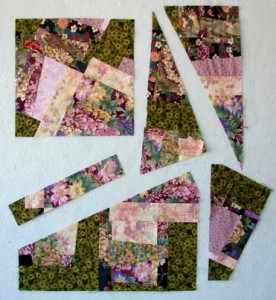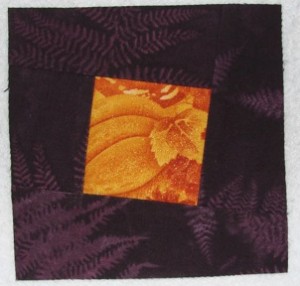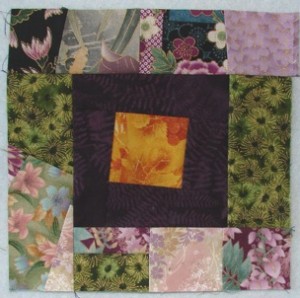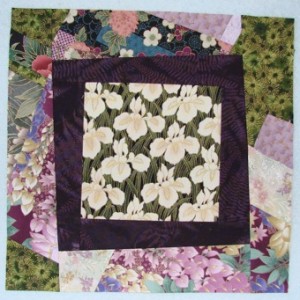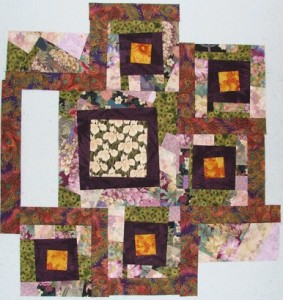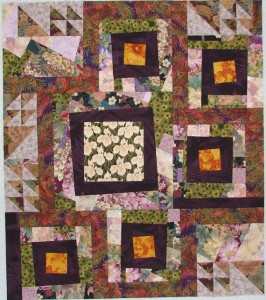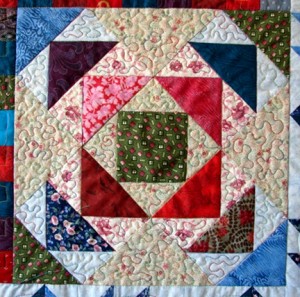The Free Motion Quilting Project had a post on QAYG quilts, something I’ve tried a few times. In fact, I’ve done a half-dozen or so Quilt-As-You-Go quilts, all with different methods. I don’t have digital pictures for all of them though.
The first one, I was learning to quilt with a walking foot and a long way from trying free-motion quilting. My sewing machine at the time did not have a way to lower the feed-dogs, and I enjoyed hand quilting, so why bother with free-motion?
But hand-quilting was out. No way could I finish a queen-size quilt in time for a wedding. Not even in time for the accepted one-year window after the wedding. And I knew I’d have trouble quilting a queen-size quilt by machine, I’d done the one for our bed with very simple straight line quilting and it was a struggle. So I figured QAYG would be the way to go. Just like me to try out a new technique on a wedding gift, too.
I made maple-leaf blocks, and quilted a simple straight-line design on them. Honestly, I don’t remember exactly what I did, either in the ditch or echo of some sort. Once all the blocks were quilted, I attached them with sashing. I cut 2 1/2 inch strips, one for the top and two for the bottom.
After trimming the blocks to the correct size, I sewed a top and a bottom sashing strip along one edge of block 1. Then on block two I sewed the other side of the top sash and the other bottom sashing strip on the bottom.
Can’t remember what I did about batting, maybe added in little strips to fill the space. Anyway, the two blocks were joined on the top, but not yet on the bottom. I ironed the top, same as I would joining two unquilted blocks, then flipped it over, took care of the batting, and ironed the two back sashing pieces over.
I folded the edge of the upper one over, to hide the raw edge, and stitched it down by hand. Once I had rows assembled I did the same thing. It made a nice two-sided quilt, as I’d used different backing fabrics for the blocks. In fact, my sister confessed she liked the back better than the front!
That quilt convinced me there had to be a way to do this without the hand sewing. I tried two methods, and no longer remember which was first. For one, I left the backing squares extra-large, at least an inch all the way around, when I layered and quilted the blocks. Then I trimmed them to a uniform size, but still bigger than the tops. I sewed the backs together first, adjusted the batting to fit, and added a 2-inch “bias” type strip (they weren’t cut on the bias) over the top, straight-stiching close to the edge to fasten it down.
In essence I appliqued a strip to cover the seam, but on the front as part of the overall design. You could do any shape you wanted, really.
I also tried doing it like the first one, but quickly basting the seam then using a quilting design along the sashing that would hold the bottom pieces in place. (A simple braid or twist worked.) For a wall-quilt you could probably leave the raw edge as is when you fold the back pieces into place, fuse it down, then quilt over it to hold everything. For this diagonal setting I also pre-quilted the triangles. Then I added the border after the center was assembled, then quilted it.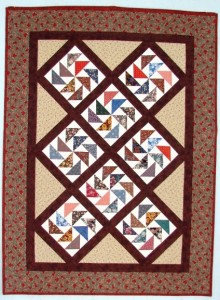
Later I made a couple of small wallhangings from blocks I had quilted earlier. I did a narrower sashing on the top, probably the same size Leah used, and hand-stitched the back. They do not hang well though. Maybe blocking then fusing a new back in place would help?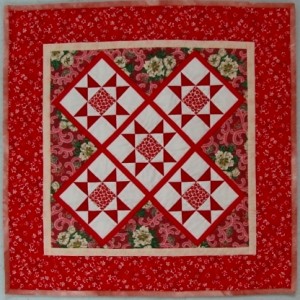
Since then I’ve tried making some quilts in sections, to be easier to quilt. This one, for example (cow quilt) was quilted in four sections then assembled. I didn’t preplan anything though, which turned out to be a mistake. I sewed the sections together like a normal seam, then contemplated what to do on the back. I ended up doing some remedial work on the back to flatten then hide the seams. I ripped out all stitching on the seam allowance then carefully cut the batting away and trimmed the backing to about an 18th inch seam allowance. I left the front fabric longer, and ironed it open. I tried fusing strips of fabric to cover the seam, but they didn’t stick well and I ended up hand-stitching strips with edges folded under over it all. That was too much work and I don’t recommend this approach! The picture was taken before quilting, so you can see the sections. I haven’t taken an after picture yet.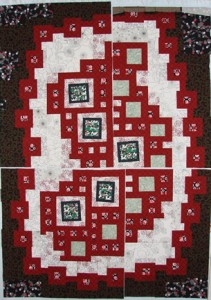
More recently, I did this one (still waiting for binding) in two sections. Smarter this time, I left the edges to be joined unquilted. Once everything else was done I sewed the tops together, trimmed the batting edges so they would butt together, folded the backs over and folded the upper one to hide the raw edge, and hand-stitched the seam. Then I went back and quilted across the seam area. Only problem I had was maneuvering the full quilt under the needle when the rest of it was all quilted. It did not want to bunch up, and insisted on moving as a solid chunk no matter how I folded or scrunched it. (I’d had trouble with the quilt above too.) Picture show the top half after quilting – I need to take a few more pictures!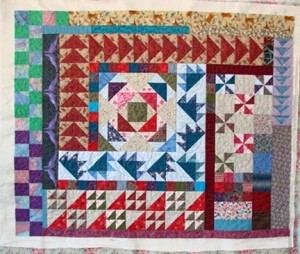
One idea I have not yet used, though I have a couple UFOs waiting, is to quilt row-length segments, starting in the center, then sewing the next row on and quilting it. Eventually you do have the full quilt to deal with, but you’re always working on the edge, never reaching into the center of a big quilt.

